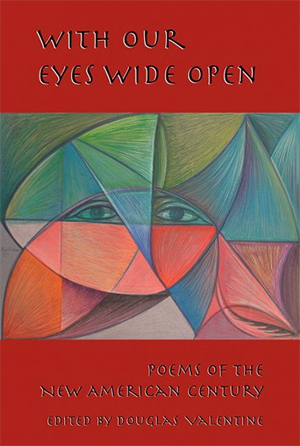Leave it to a poet to note that so many of the
casualties on 9/11 at the World Trade Center were from many other parts of the
world.
Praise Manhattan from a hundred and seven
flights up,
like Atlantis glimpsed through the windows
of an ancient aquarium.
Praise the great windows where immigrants
from the kitchen
could squint and almost see their world,
hear the chant of nations:
Ecuador, México, Republica Dominicana,
Haiti, Yemen, Ghana, Bangladesh…
That’s how poet Martin Espada commemorated, in
“Alabanza: In Praise of Local 100,” the cooks, dishwashers, waiters and
waitresses who died in the Windows on the World restaurant that day.
This perspective sets the tone for With Our Eyes Wide Open: Poems of the New
American Century (West End Press, 2014), edited by Douglas Valentine, an
edgy, protest-minded anthology presenting a hard-eyed, often bitter look at how
many poets see the world today.
Julia Stein traces, in “Iraqi Poets Society,” the poetic
impact of the US military invasion and overthrow of the monstrous dictator
Saddam Hussein:
…dreams grew that poems would
erase
all the roadside bombs…
Iraqi poets now were breathing
poems again.
For a few days, a few weeks, a
few months, poems sprouted…
up and down the Baghdad streets.
When they began the terrible
count:
“One poet was threatened. One
was kidnapped.
One was killed. One fled
abroad.”…
… suicide bombs exploded on the
street
leaving corpses and the wounded.
Many of the poems in this collection are by poets from
other parts of the world raising their voices against the corrosive violence that
swirls like desert sand storms through their homelands and other places they
care about—Central America, Palestine/Israel, across the Middle East, North
Africa. A poet from Tunisia, Tahar Bekri, worries about what is tearing
Afghanistan apart. A poet from Morocco living in Belgium, Taha Adnan, worries
about a friend’s Facebook page being overshadowed by nationalistic flags in a
revolution-and-reaction-torn homeland.
Other poems are by American veterans of our wars in
Korea, Vietnam, Iraq and around the world. Brian Turner writes in “VA Hospital
Confessional” about battles that continue long after coming home.
Some nights I hear a woman
screaming
Other nights I shoot the
crashing car.
When the boy brings us a platter
of fruit,
I mistake cantaloupe for a human
skull…
This collection of glass-smashed poetry tries to convey
the horrendous impact on people of the seemingly ceaseless wars that politicians
and the news media treat as backdrop to their preening self-promotions and heedless,
reckless, careless ambitions.
The next time you see a VIP wrap himself in the flag of honoring
the dead of 9/11 and calling for more war, remember these lines from Martin
Espada’s tribute to the workers from around the world who died in the towers:
…When the war began, from
Manhattan to Kabul
two constellations of smoke rose
and drifted to each other,
mingling in icy air, and one
said with an Afghan tongue:
Teach me to dance. We have no music here.
And the other said with a
Spanish tongue:
I will teach you. Music is all we have.









